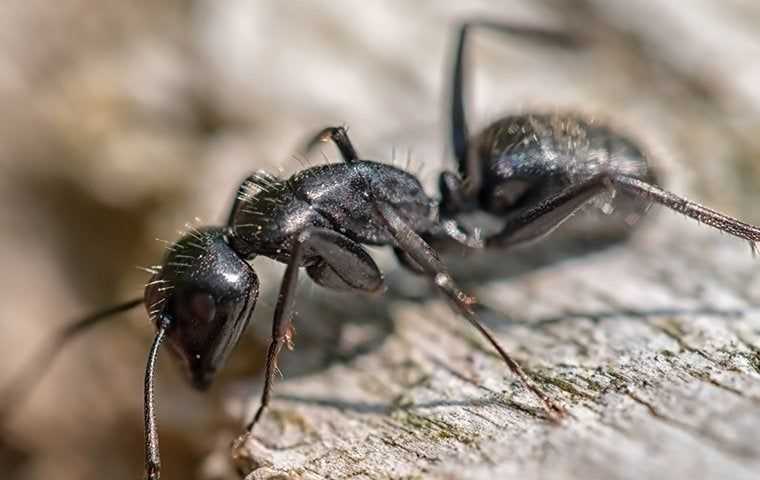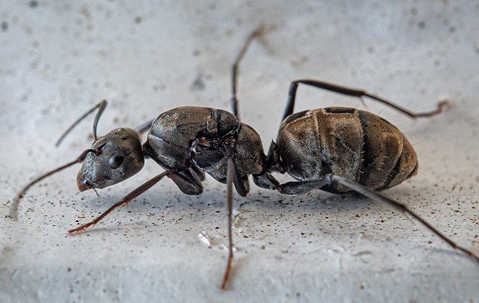Carpenter Ant Identification Guide
What are carpenter ants?
Large and destructive are two words that best describe a carpenter ant. Worker carpenter ants grow to about half an inch long, while the queens grow to about an inch. If you see large black or black and red ants wandering around your yard or inside your home, you are likely dealing with carpenter ants. Carpenter ants also are identified by narrow waists, elbowed (bent) antennae, and hind wings shorter than front wings — though only reproductive ants have wings.
While it is important to be able to recognize different types of ants, it's good to have a general idea of what carpenter ants look like. Correct identification by a professional is essential to ensure effective treatment measures are implemented.
As a wood-tunneling pest, carpenter ants can damage a home or other building’s structural wood when they nest in it. Carpenter ant tunnels and nesting galleries are extremely clean and smooth and without sawdust or other debris.

Are carpenter ants dangerous?
The damage that carpenter ants cause to homes in the Cypress area can vary. Since they tunnel through wood to nest in, not feed on, their damage often occurs slowly and over a long period. Meaning, if you are vigilant, it is possible to eliminate carpenter ants before they cause extensive damage. However, if left up to their own devices, the damage they cause can be quite significant and costly.
Carpenter ants do not bite or sting, but like other ants, they can contaminate food and spread bacteria over the surfaces they crawl on.
Why do I have a carpenter ant problem?
Carpenter ants forage for food in various places. Those with nests in our yards gather food for the colony from the following:
- Trash cans and recycling bins
- Gardens
- Compost piles
- Pet food
- Outdoor eating areas
Carpenter ants are a threat to any property, but properties with lots of vegetation, trees, or near wooded areas or parks are often most susceptible.
Where will I find carpenter ants?
Carpenter ants typically have a main nest outside that they build inside decaying trees roots, tree stumps, fallen trees, logs, or wood construction debris. Like other ants, food often attracts carpenter ants to a property; they prefer to feed on proteins and sugar.
These ants often find a way inside a home through tiny cracks and openings while foraging for food. Unlike termites, these wood-destroying pests do no feed on wood.
Once inside, if the ants find a food source and locate wood damaged by water, usually due to leaking pipes, condensation, and poor ventilation, they often stay and create a satellite nest. Areas of a home that carpenter ants commonly place a nest include:
- Behind bathroom tiles, tubs, showers, or sinks.
- Behind dishwashers or refrigerators.
- Structural wood near windows and doors.
- Behind walls voids and under floors
How do I get rid of carpenter ants?
Carpenter ants not only spread bacteria and contaminate food like other ants, but they can also cause structural damage if they decide to nest inside our homes or businesses. At TNT Home & Commercial Services, we offer a professional solution that will rid your Greater Cypress area property of carpenter ants and stop them from returning. Our focus is customer satisfaction and ensuring our customer’s properties are free of carpenter ants as well as our area’s other most common pests! To learn more about our carpenter ant control solutions, reach out to TNT Home & Commercial Services today.
How can I prevent carpenter ants in the future?
More than an inconvenience, pests can be dangerous and cause a lot of damage. In addition to our professional home pest control and commercial pest control services, use the following tips to keep carpenter ants out of your home:
- Make sure gutters are clean, and downspouts are directing water away from the walls of your home.
- If your house has wood trim or wood shingles, ensure the wood has been painted, stained, or otherwise treated to prevent it from becoming damaged by water.
- Remove tree stumps, fallen trees, and woodpiles from your yard.
- Remove entry points leading into your home. Replace missing or damaged screens and vents.
- Repair gaps in the foundation and damaged door or window trim. Seal openings around vents, pipes, and cables entering your house.
- Use dehumidifiers and air conditions to control humidity levels in your home to reduce the chance of wood becoming water-damaged and attracting nesting carpenter ants.
- Remove the temptation of food from both inside and outside your home. Keep lids on trash cans and recycling bins, maintain gardens, regularly vacuum your floors and wipe down counters and tables.

